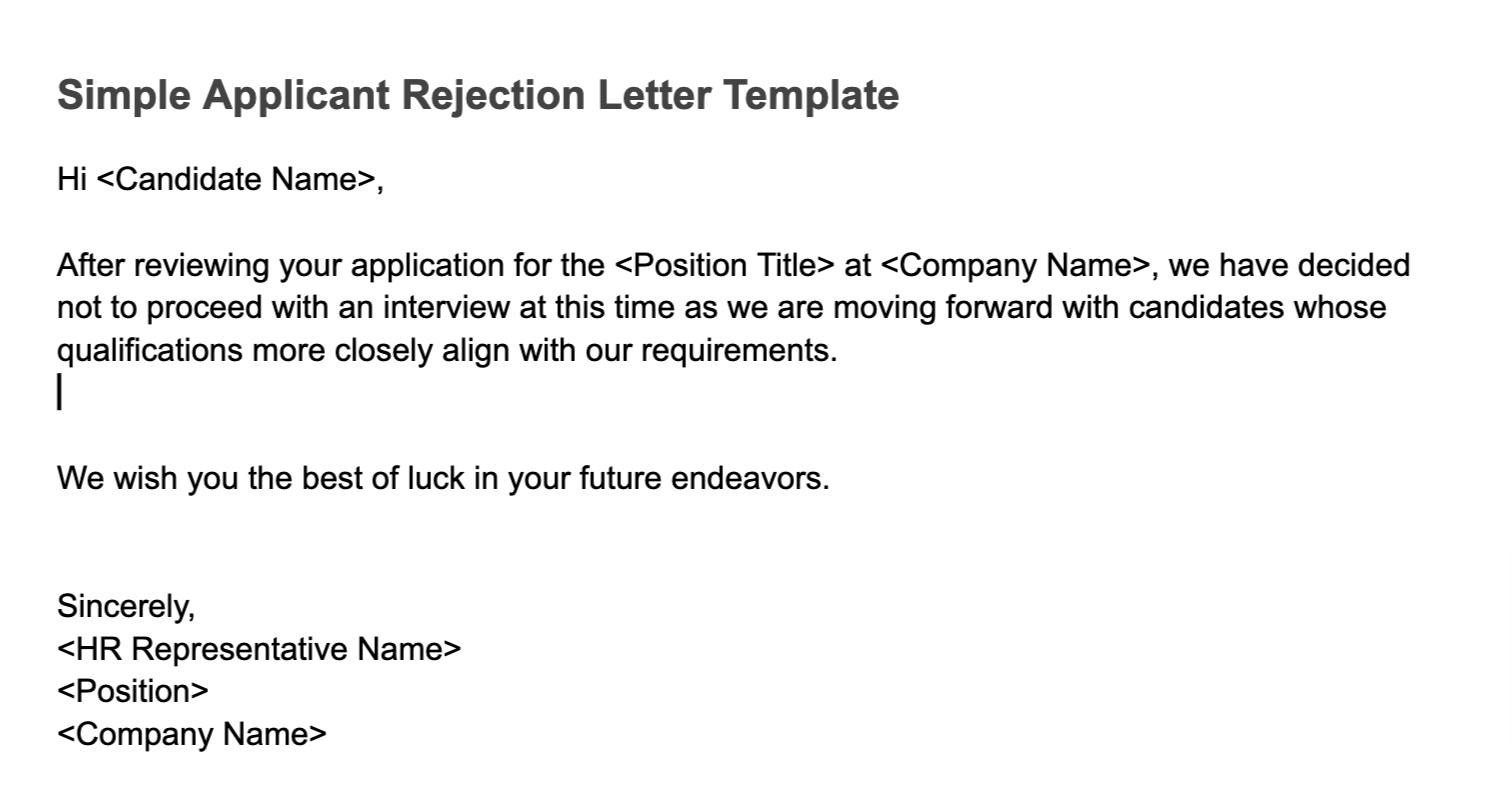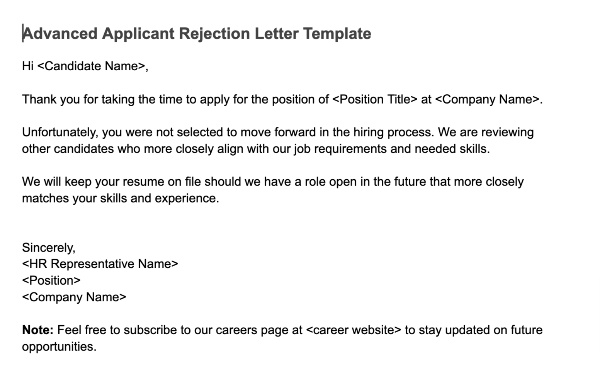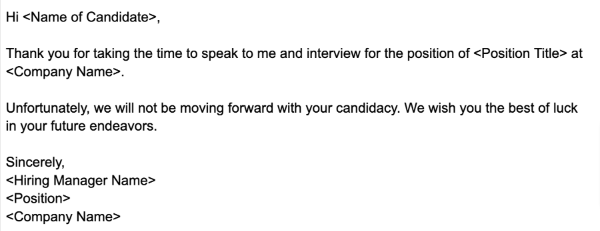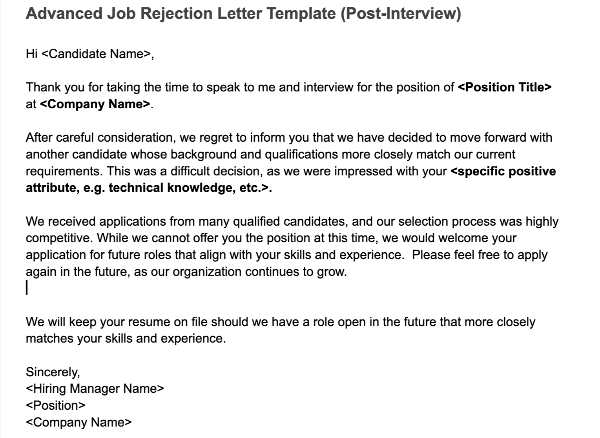A job rejection letter serves to notify a potential candidate that you are no longer considering them for your open position. It may also provide reasons you didn’t hire the candidate, though we recommend being careful about how much detail you share. This letter also serves as legal documentation. The type of job rejection letter you send depends on the candidate’s stage in the hiring process.
We have provided five templates for your use: simple and advanced post-interview rejection letters and simple, and advanced applicant (pre-interview) letters. All templates are brief and straightforward and can be used as formal written letters or emails.
| Do | Don’t |
|---|---|
| Keep the letter or email professional, courteous, and brief | Apologize or use negative language |
| Designate one person in your company to be the contact person for all applicants | Ghost applicants |
| Send a rejection letter as soon as a decision is made | Have employees send rejection emails that aren’t vetted |
| Emphasize that there were many great applicants and interviews | Discuss the qualifications of other candidates |
| Tell a candidate they have good qualities | Tell a candidate they were perfect for the role |
| Be respectful | Discuss personal details about a candidate (like their health or pregnancy) |
Types of Job Rejection Letter
Here are four different types of job rejection letters that you can download and customize according to your preference.
What to Include in a Rejection Letter
When writing a job rejection letter or email, keep it simple and send it within 24–48 hours of your decision to reject the candidate. It’s typical to send job rejection letters via email so candidates learn about your decision as soon as possible.
Be sure to address the candidate by name at the top of your job rejection letter. This makes the letter personalized to the candidate vs a general rejection letter. A salutation sets the tone for the rest of the letter.
Next, thank them for applying for the position. Be specific and list the actual position applied for and also mention your company name. This acknowledges the time they took to apply for the position and the time and effort they put into any interviews.
Example:
Dear John,
Thank you for taking the time to apply for the Marketing Manager role at ABC Company.
Once you have addressed the candidate and thanked them for applying, it is now time to get to the reason for the letter. This can be done in one of two ways. First, you can simply let the candidate know they are no longer being considered for the position. This method is efficient and gets right to the point.
Another way to let the candidate know they are not being considered for the position is to explain that you are going in a different direction. This version lets the candidate know why they weren’t selected, albeit generically and vaguely.
Example:
Unfortunately, you were not selected to continue in the hiring process. We have decided to move forward with other candidates who more closely align with our job requirements and needed skills.
Highlight one of two positive aspects of the candidate’s application or interview performance. This helps soften the blow of rejection and leaves the candidate with a constructive takeaway. It’s important to be genuine in this feedback; mention specific skills, experience, or qualities that stood out to you. This approach not only helps maintain the candidate’s morale but also reinforces that the evaluation process was thorough and fair.
Example:
Your enthusiasm for our company’s mission and your excellent communication skills were noteworthy during the interview process.
If appropriate, let the candidate know that you’ll keep their information on file for future openings. This is especially relevant if the candidate was a strong contender but was edged by someone with slightly better qualifications, or if you anticipate similar positions opening up in the future. However, only include this if it is a genuine possibility, as false hope can damage your company’s reputation.
Example:
Given your strong qualifications, we would like to keep your information in our database for potential future opportunities.
If your company has other positions that might be suitable for the candidates, or if you regularly have similar openings, encourage the candidate to apply for these. This shows that you value their interest in the company and see potential in them even if this particular position isn’t the right fit for them. It also keeps the door open for future interactions, which can be beneficial for both the candidate and your company.
Example:
We encourage you to review our careers page and apply for other positions that match your skills and career goals.
End your letter positively, wishing the candidate well in their job search and future endeavors. The final touch of goodwill can leave the candidate with a favorable impression of your company, despite the rejection. A positive closing can help maintain your company’s reputation and keep the lines of communication open for potential future interactions.
Example:
We wish you the best in your job search and your future professional endeavors
Reasons for Rejecting a Candidate
There are several reasons for rejecting an applicant and sending that rejection letter. Here are a few of them:
- Lack of qualifications: The candidate doesn’t meet the minimum requirements specified in the job description.
- Inadequate skills or experience: Although the candidate meets the minimum requirements, their skills and experience don’t align closely enough with what the job description demands.
- Poor interview performance: If the candidate performed poorly during the interview, this could show a lack of enthusiasm or preparation for the interview.
- Overqualification: While it might look counterintuitive, many employers think that an overqualified candidate will become bored or frustrated in the role and look for a better opportunity.
- Background or reference issues: This might include discrepancies in employment history, undisclosed criminal records, or poor references from previous employers.
- Budget constraints: A highly qualified candidate has salary expectations that exceed the company’s budget for the role.
- Concerns about long-term commitment: A candidate’s work history shows a pattern of frequently changing jobs.
You can customize the letter to include specific reasons, such as a clear skill deficiency (not enough marketing or technical knowledge). We recommend keeping the letter skill-focused or not mentioning a reason at all. Don’t include the following:
- Protected characteristics: age, gender, religion, disability, national origin, marital status, pregnancy status, sexual orientation, race/ethnicity
- Performance qualification: experience gaps, educational background comparisons, test scores or assessment results, personality traits or concerns, communication style issues
- Comparative information: Other candidates’ qualifications, number of applicants, internal candidate preference, team dynamics considerations
Legal Considerations
When writing job rejection letters, companies must carefully consider legal implications to avoid potential discrimination claims or lawsuits. While it’s important to document the specific reasons for non-selection in the candidate’s internal file (such as failed technical assessments, poor cultural fit, lack of required skills, or interview performance), these should never be included in the rejection letter itself.
Keep external communications brief and neutral. The rejection letter should never reference protected characteristics, such as age, gender, race, religion, disability, national origin, or marital status. Avoid mentioning specific qualifications, experience levels, or comparisons to other candidates, as these details could be used to claim discriminatory hiring practices.
Keep all communications documented and consistent across all rejected candidates. If maintaining rejection letters and internal candidate evaluations in company records, ensure they follow document retention policies and data privacy regulations like GDPR where applicable. Avoid making promises about future opportunities or keeping applications on file unless this is a standard company practice.
Key legal concerns to consider:
- Discrimination claims based on protected classes
- Implied promises of future employment
- Defamation risks from negative statements
- Privacy regulations regarding candidate data
- Documentation requirements for equal opportunity compliance
- Consistency in communication across all rejected candidates
When you send a job rejection email, some candidates might reply asking for more information. These responses can vary in tone and professionalism. While it’s tempting to engage, the best approach is to simply file the email and move on.
Don’t respond if a rejected candidate threatens legal action, but also don’t ignore it. Pass this email to your legal or HR team so they can review the candidate’s file to ensure there was a nondiscriminatory reason for rejection.
Ultimately, you can’t stop people from suing your business. But you can be as prepared as possible to tackle those legal challenges.
Documenting Your Job Rejection Letters
You should document all stages of the hiring process, including job rejection letters. If you have an applicant tracking system, like ZipRecruiter, you can send and store these letters right through the software. If you don’t have one of these systems, track all stages in an Excel spreadsheet or a Word document.
As mentioned above, clear documentation helps protect your company from possible Equal Employment Opportunity Commission (EEOC) discrimination laws. These laws make it illegal for an employer to deny employment to a candidate based on age, race, sex, religion, natural origin, and pregnancy.
Job Rejection Letter Frequently Asked Questions (FAQs)
Send the rejection letter as soon as possible after your final decision and acceptance from your chosen candidate. This shows respect for the candidates’ time and allows them to pursue other opportunities. Delaying notifications can negatively impact your company’s reputation.
While it’s best practice to respond to all candidates, priority should be given to responding to those who were interviewed. For high-volume positions, an automated response system for non-interviewed candidates is acceptable. However, anyone who was interviewed should receive a personalized rejection letter.
Only if you genuinely want them to apply again and have a standard policy of keeping applications on file. Don’t make promises or give false hope, as this could create legal obligations or expectations.
Bottom Line
Sending a job rejection letter to a candidate letting them know they are not a fit for your open position is good business practice. It lets them know you appreciate the time and effort they invested in applying or interviewing for the position and may protect your company from possible legal issues. Be sure to keep documentation on all correspondences you send and receive.





